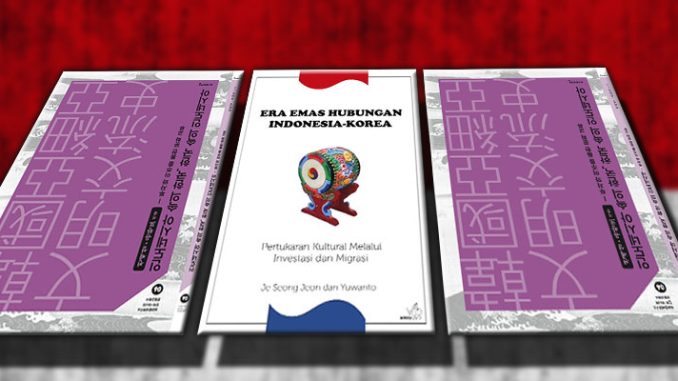
인도네시아 속의 한국, 한국 속의 인도네시아 – 투자와 이주를 통한 문화 교류
(Korea in Indonesia, Indonesia in Korea – Cultural Exchange Through Investment and Migration)
By 전제성(Jesong Jeon), 유완또 (Yuwanto)
Seoul: Imagine, 2013
Era Emas Hubungan Indonesia-Korea: Pertukaran Kultural Melalui Investasi dan Migrasi
Jesong Jeon and Yuwanto
Jakarta: Penerbit buku Kompas, 2014
Considering that Koreans comprise the largest number of foreign residents in Indonesia, and that Korea’s investment in Indonesia has been continuously on the rise, this book came out at a very opportune time. Moreover, the fact that 2013 was the 40th anniversary of diplomatic relationships between South Korea and Indonesia adds even more importance to this book, as it highlights various exchanges between two nations. As the authors mention, relationships between Korea and Indonesia have been solid and amiable and are currently in “the golden period” (p.12). While this book demonstrates the positive growth of these relationships, it also raises social problems that have been generated through mutual exchange between two nations.
![KOREA-INDO-[CO-FINAL-ACC]2](https://kyotoreview.org/wp-content/uploads/KOREA-INDO-CO-FINAL-ACC2.jpg) The book is divided into three parts. The first chapter briefly deals with the historical development of diplomatic relationships and mutual exchange between South Korea and Indonesia; the second chapter examines ‘Korea in Indonesia,’ focusing on the types and challenges of Korean investment, and the characteristics of Korean residents in Indonesia over several generations; chapter three deals with ‘Indonesia in Korea,’ examining the stories of Indonesian migrant workers in Korea, and interracial marriages between Koreans and Indonesians.
The book is divided into three parts. The first chapter briefly deals with the historical development of diplomatic relationships and mutual exchange between South Korea and Indonesia; the second chapter examines ‘Korea in Indonesia,’ focusing on the types and challenges of Korean investment, and the characteristics of Korean residents in Indonesia over several generations; chapter three deals with ‘Indonesia in Korea,’ examining the stories of Indonesian migrant workers in Korea, and interracial marriages between Koreans and Indonesians.
Chapters 2 and 3 are crucial chapters, providing substantive knowledge about Koreans in Indonesia and vice versa. In Chapter 2, the authors divide Korean investment into two periods. The first wave of Korean investment in Indonesia began around the late 1980s and early1990s. It was also the time when a sizable Korean society started to appear in Indonesia. The second wave of Korean investment began around 2000, which was driven by small and medium-sized companies. While the amount of Korean investment is in second place after Japan, Koreans run mostly labor-intensive industries. As Korean companies hire many Indonesians, compared to other foreign companies in Indonesia, there have been frequent labor disputes in Korean companies in Indonesia. Disputes involve wages, welfare provision, or labor relations. At times, Korean company owners closed down companies illegally without compensating workers properly. In addition to these issues, outsourcing and, more notoriously, sexual harassment have become big issues. The authors explain that the disputes are because of cultural difference. Koreans have an authoritative management culture while Indonesians have paternalistic expectations toward company owners. Such differences often clash and that is why disputes occur. While this explanation provides some interesting insight into Korean labor practice, the authors do not provide alternative explanations as to why there are many disputes in Korean companies. Exploring them might have given readers more knowledge about labor disputes that often occur in Korean companies overseas.
Chapter 3 is equally compelling, and deals with two topics: immigrants and interracial marriages. As of 2012, 38,000 Indonesians live in Korea – the eighth largest population of foreign residents in Korea (p. 99). Although most of them are documented migrant workers, they are experiencing many challenges while living in Korea due to authoritative labor practices. This chapter documents the experiences that Indonesian migrant workers face. While migrant workers have been an essential part of Korea’s economy, institutional support for them is considerably lacking.
Similarly, for the last decade, interracial marriages in Korea have been rapidly rising. In the 1990s, the rate was 1.2%, but was ten times higher in 2007 (p.101). Many foreigners married Koreans through private agencies that introduce foreign brides to Korean bachelors. Case studies offer rich personal stories as well as illustrating many hurdles that Indonesian brides experience. However, the authors also remind us that migrants are not victims. Instead, we need to treat them equally. They are creating their own culture in foreign society by organizing themselves through informal meetings and associations, and expressing their lives in art forms like music.
The authors conclude the book by suggesting that relationships between Korea and Indonesia should go beyond pure economic interest, and should be consolidated in various aspects. In order to do so, both Koreans and Indonesians should enhance their understanding about each other’s history, language, culture, arts, politics, and economy. Moreover, encouraging academic study of each other’s countries would contribute to solidifying the relationships.
In short, this is an excellent book that will be of use in undergraduate society and culture classes on Korea and Indonesia, and for scholars who wish to learn more about Korean investment in Indonesia, and Indonesian migrant workers and interracial marriages in Korea. It is also highly recommendable to members of the general public who are interested in investing in Indonesia or in Indonesians migrating to Korea. This book is available both in the Korean language and Bahasa Indonesia.
Eunsook Jung
Dr. Eunsook Jung is an assistant professor in the Department of Political Science at the University of Wisconsin-Eau Claire.
Kyoto Review of Southeast Asia. Issue 15 (March 2014). The South China Sea
